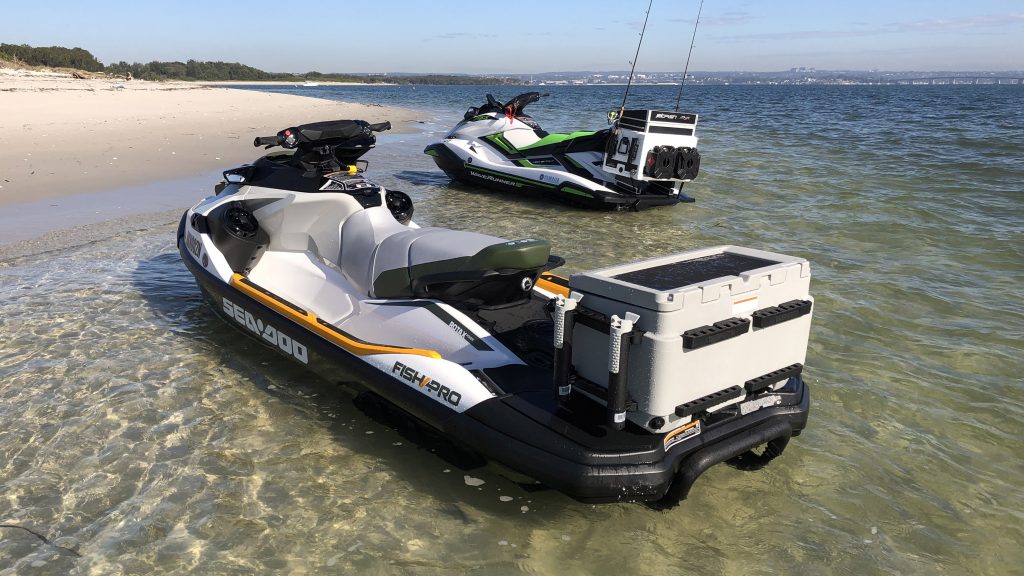Fishing off a Jet Ski has grown in popularity as personal watercraft have become larger and more stable – and as innovative suppliers adapt to this new offshoot of the sport.
It is rare to carve out a new niche in any industry, but Sea-Doo has done just that with its Fish Pro watercraft – a ready-to-ride machine that has everything you need, straight off the showroom floor.
When the Sea-Doo Fish Pro was unveiled in late 2018 as a 2019 model year, it took the industry by surprise.
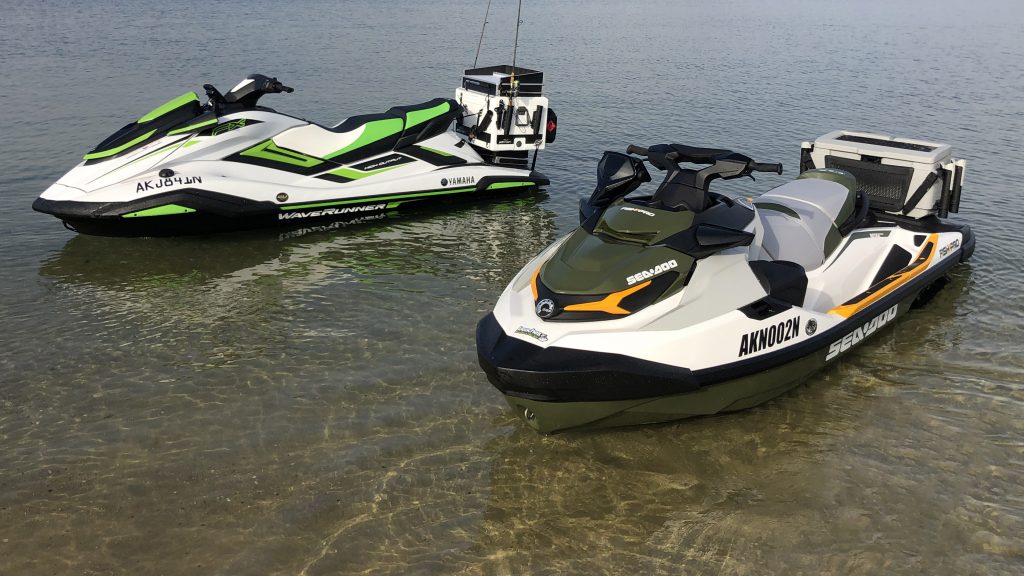
The Yamaha FX series had dominated the fishing watercraft market for more than a decade, but for a long time owners had to buy bolt-on parts and come up with their own attachments, cooler boxes, and fishing rod holder designs.
The Yamaha FX found favour among keen anglers thanks to stability in rough water, its large flat rear deck, and large fuel tank capacity (70 litres versus 60 litres on Sea-Doo at the time, though comparable Sea-Doo models have since grown to 70 litres).
The other large personal watercraft, the Kawasaki Ultra Jet Ski, has a 78-litre tank. But its comparatively small rear deck made it difficult (though not impossible) to fit a fishing kit.
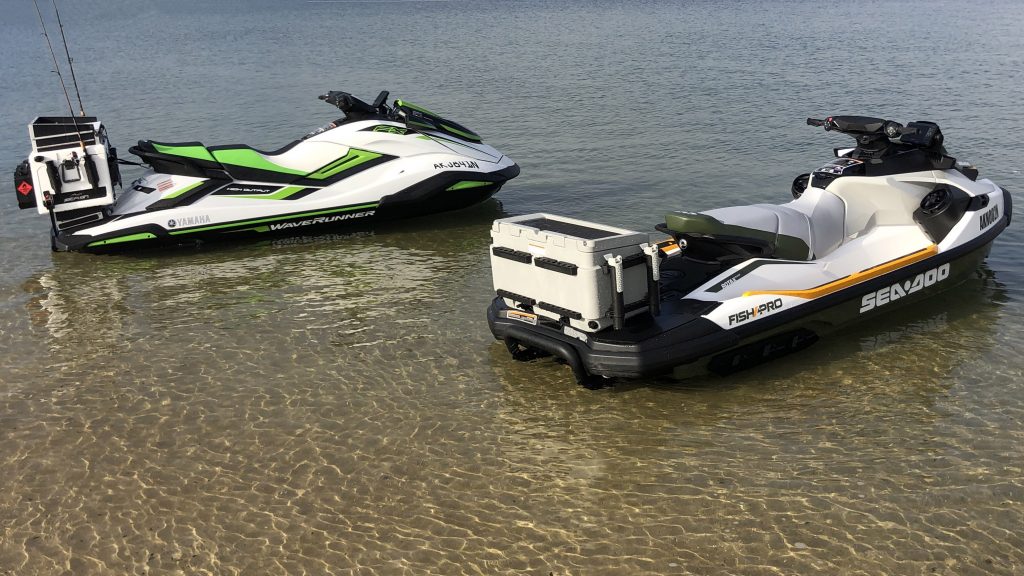
So Yamaha largely had the fishing market to itself in the personal watercraft world, until Sea-Doo discovered Jet Ski fishing expert Andrew Hill from New Zealand.
Hill was a long time Yamaha FX rider until, one year, he made the shift to Sea-Doo after Yamaha ran out of local stock.
When Sea-Doo head office in Canada heard an experienced Jet Ski fisherman in New Zealand wanted to modify his watercraft to go fishing, they sent an expert to the other side of the world to find out more.
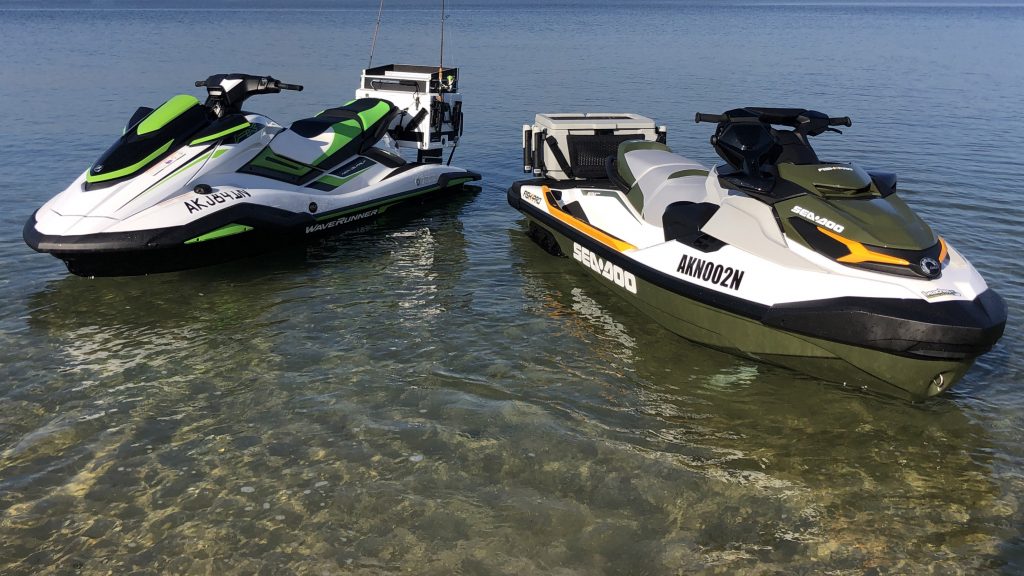
The rest, as they say, is history. Andrew Hill was embedded with Sea-Doo designers and engineers and he was the lead consultant on the project, which took several years to complete, from concept to showrooms.
Andrew Hill is the reason the Sea-Doo Fish Pro is so well thought-out. It was designed by a Jet Ski fisherman for Jet Ski fishermen.
Genius ideas include the non-slip angled gunwale foot rests (to prevent scuffing the side of the craft and to improve stability and grip when fetching a catch out of the water), the 51-litre cooler with a grip mat (and measurements etched into the lid so you can measure your catch), and the position of the fish finder and navigation screen in place of the right side mirror. The list goes on.
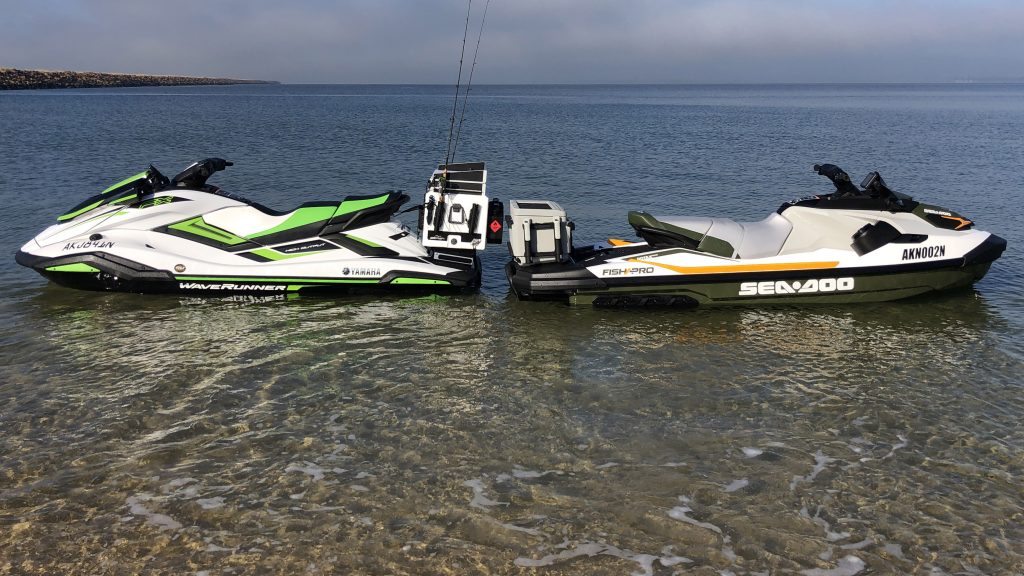
The clever layout, design, and storage solutions built into the new-generation Sea-Doo ST3 deck (on which the Fish Pro is based) also make the Fish Pro user-friendly.
However, Yamaha is still in the game – and still a favourite among diehard fans.
The latest generation Yamaha FX Series (released in late 2018 as a 2019 model year) has a larger and flatter rear deck than before, which makes it easier to attach a large cooler box and other fishing accessories.
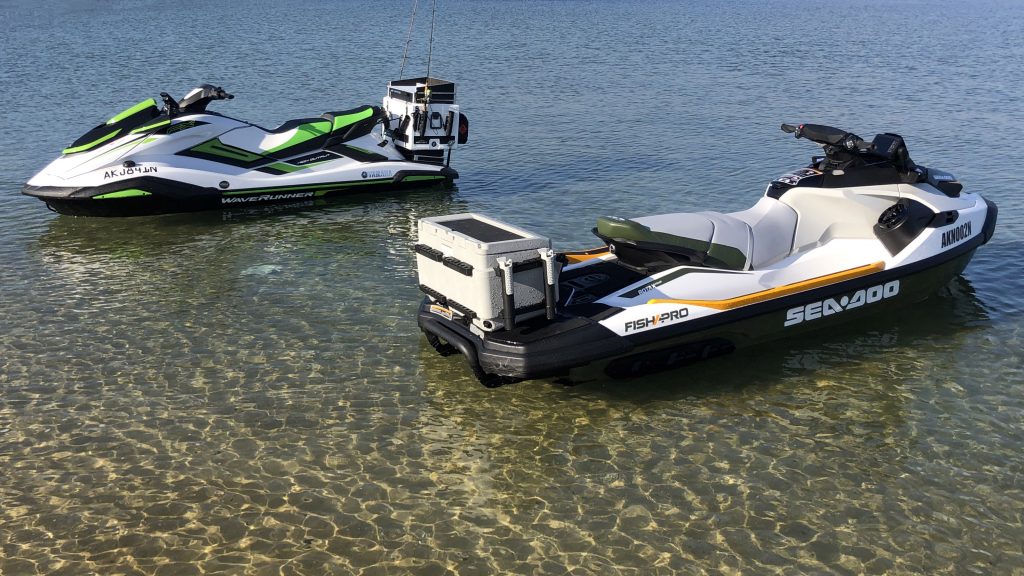
Some Yamaha FX owners continue to come up with their own solutions.
However, a Queensland-based company has adapted a design it has been working on for years, to cater for the latest Yamaha FX Series, as well as Kawasaki and other Sea-Doo models.
After starting out with a rod holder bolted to the back of a jet ski, and then using an old milk crate to store the catch of the day, Queensland’s FishSki eventually perfected a sturdy, custom-made design after a lot of trial and error.
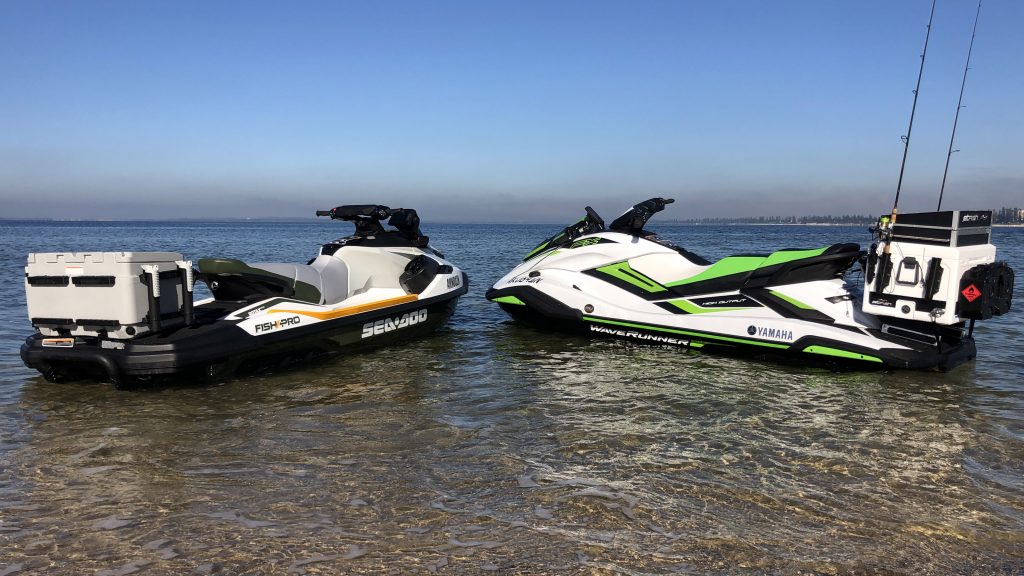
There are four main types of FishSki cooler box in up to eight colours which can be adapted to fit Yamaha, Kawasaki and Sea-Doo.
With that in mind, we got these two fishing watercraft together in a back-to-back test to assess these two different approaches.
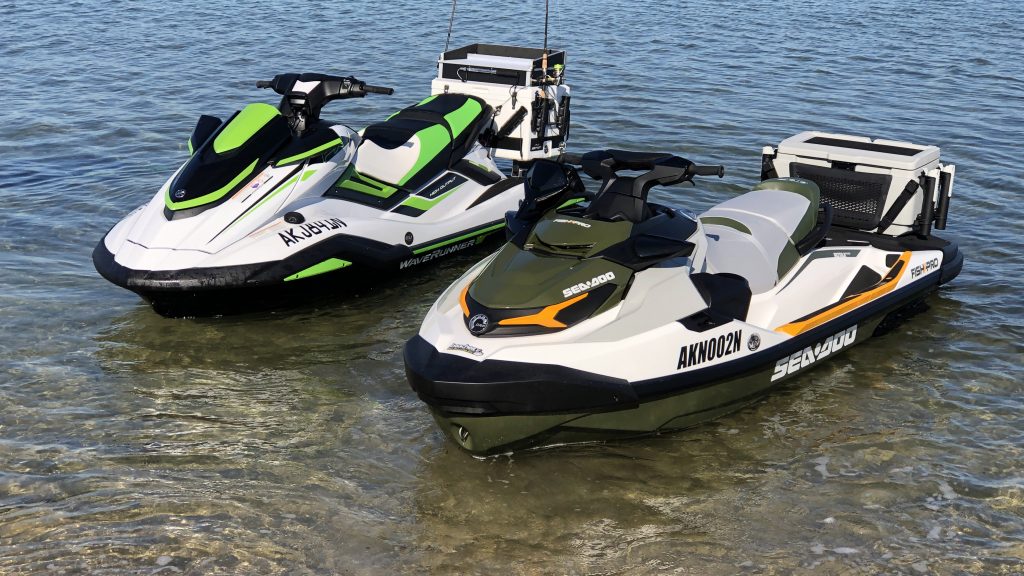
What do we have here?
The Sea-Doo Fish Pro is a specialised version of Sea-Doo’s ST3 hull and deck family – the largest three-seater in its current range – and comes ready to go fishing, straight off the showroom floor.
Sea-Doo fans who want performance can also buy Fish Pro accessories separately for any other ST3-based model, such as the supercharged GTX 300 Limited and RXT-X RS 300 high-performance watercraft.
The Yamaha FX HO is Yamaha’s largest watercraft and, as with the Sea-Doo Fish Pro, is also a three-seater. It’s available with flat seats or with optional tiered seating, as part of the Yamaha FX HO Cruiser pack.
Yamaha fans who want more performance have the option of the supercharged FX SVHO models. The same accessories fit on the Yamaha FX HO and FX SVHO, as the bodywork is identical.
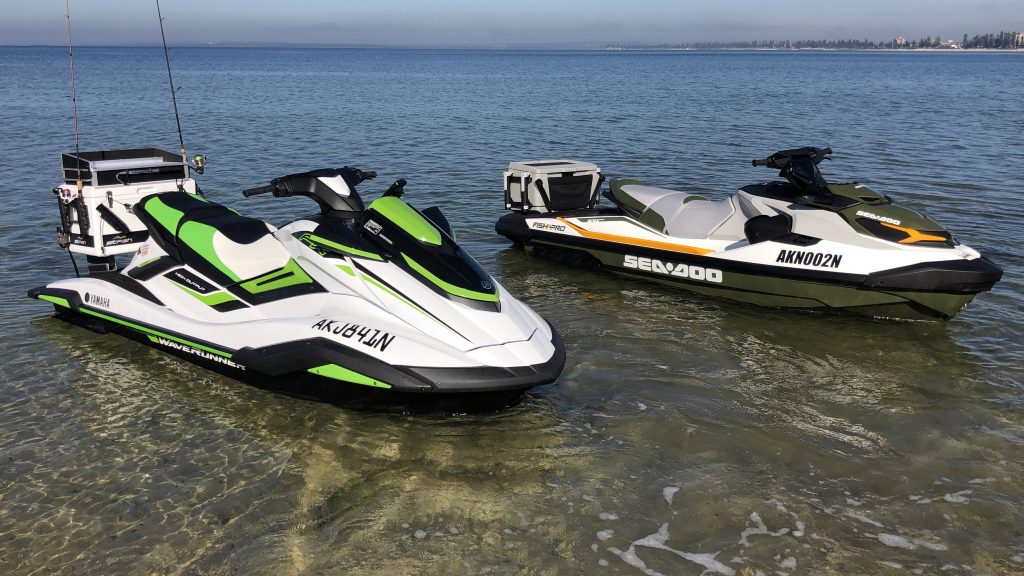
Engines
The original Sea-Doo Fish Pro came out with a 1503cc three-cylinder engine with 155 horsepower in late 2018 as a 2019 model year.
The Sea-Doo Fish Pro engine was upgraded to a 1630cc three-cylinder with 170 horsepower in late 2019 as a 2020 model year. This 170hp engine continues with the 2021 model.
The Yamaha FX HO is powered by a 1.8-litre four-cylinder engine. Yamaha does not publish a power claim for this engine or the supercharged version of the 1.8-litre four-cylinder, however both represent the largest capacity engines in the personal watercraft class.
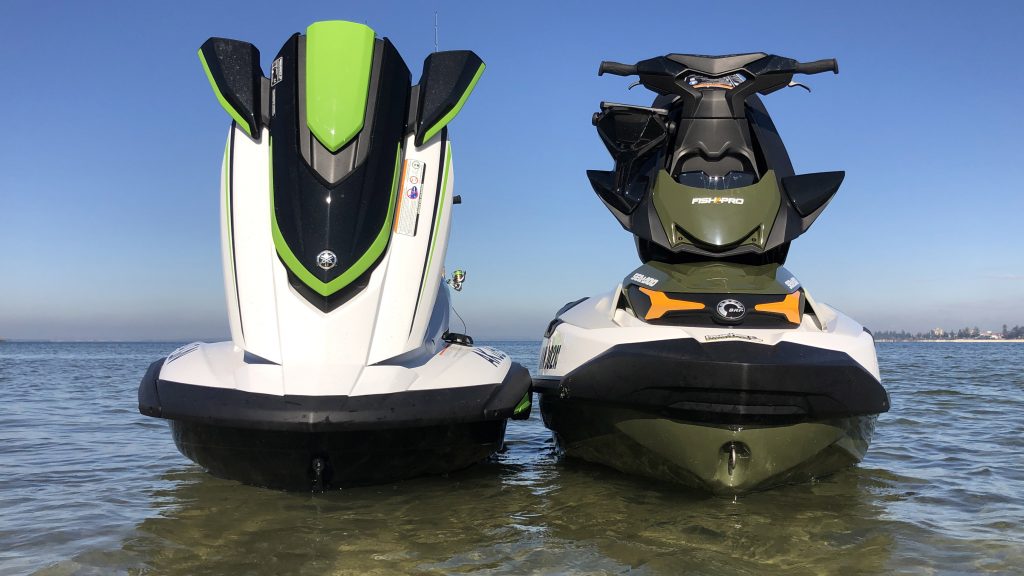
Prices
The 2020 Sea-Doo Fish Pro costs $20,499 not including trailer and registration, which typically adds between $1500 and $2000 depending on fees in each state and the quality of the trailer. For 2021 the price has risen to $20,699. Factory-fitted Bluetooth audio speakers (as shown on the example tested) add $1000 to the cost.
The Sea-Doo Fish Pro comes with factory-fitted accessories such as a cooler box and navigation system, making it ready to go straight off the showroom floor.
The 2020 Yamaha FX HO costs an identical $20,499 not including trailer and registration, which typically adds between $1500 and $2000 depending on fees in each state and the quality of the trailer. For 2021 the price has risen to $20,599. It’s worth noting this generation Yamaha FX HO debuted in 2019 at $20,099.
To prepare the Yamaha FX for sport fishing, it needs to have the FishSki kit, navigation, and fish finder added at an additional cost. (FishSki box $1249, Garmin ECHOMAP Plus 45cv with a GT20-TM transducer $499).
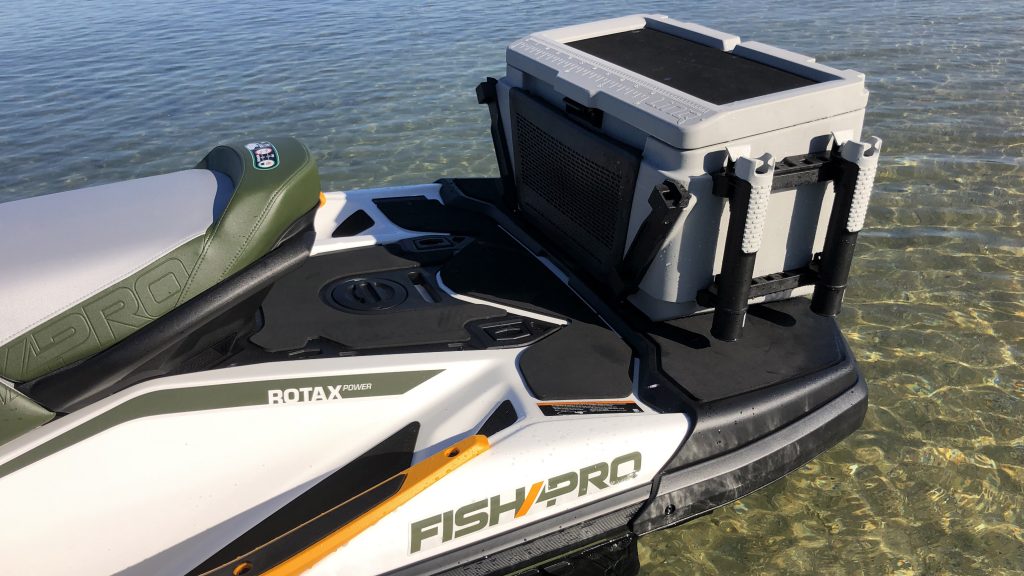
The fishing gear
The Sea-Doo Fish Pro comes with a factory-fitted Garmin EchoMap Plus 62cv fish finder, and a 51-litre cooler box which is mounted on the extended rear deck. It also comes with angled gunwale footrest strips along each side of the watercraft, a storage bin organiser, and four fishing rod holders.
Popular Sea-Doo options include a 15-litre fuel caddy ($200), a 20-litre removable storage box ($200), and an extra storage compartment that sits on top of the Fish Pro’s 51-litre cooler box ($349).
New for the 2021 Sea-Doo Fish Pro: two extra rod holders mounted on the left and right side of the front console. They can be retro-fitted to earlier examples of the Sea-Doo Fish Pro at a cost of $38 each.
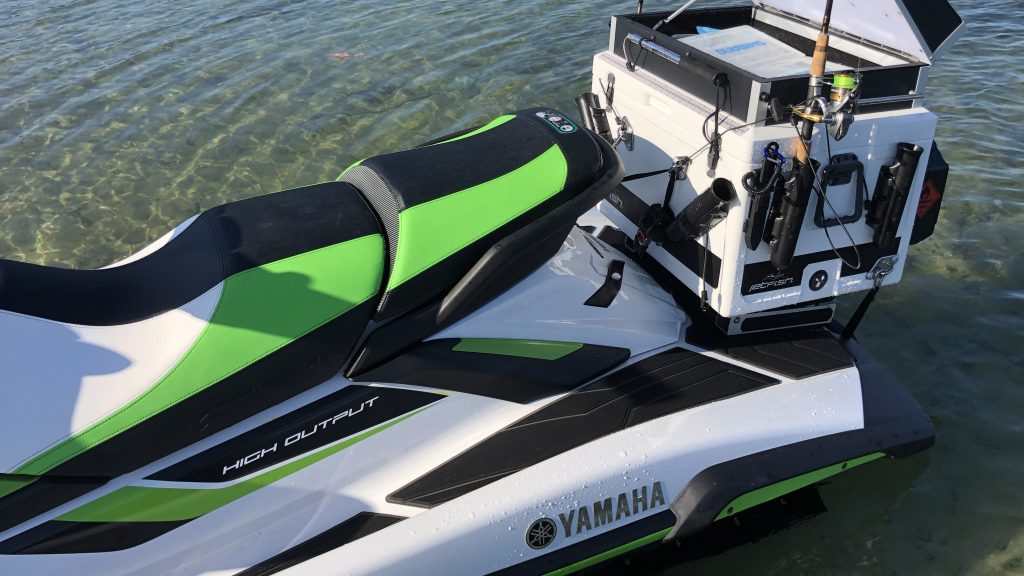
The Yamaha FX HO tested was equipped with the FishSki 68 Deluxe. It’s a 68-litre cooler box (ice-rated for five days) that also comes with an 18-litre carpeted tackle box.
Instead of a grip mat on the lid (as per the Sea-Doo Fish Pro) there is a “food rated” plastic chopping board with a bait well, a fishing knife and sheath, six rod holders (two on each side and two on the front of the cooler box, each with an elastic lanyard to secure the rods in position), and two 5-litre fuel bladders mounted on the back.
Two stainless steel tie-down rails latch onto the tow hook behind the back seat of the Yamaha FX HO. Four height-adjustable “feet” enable you to sit the cool box almost flat on the rear deck. Two stainless steel ratchet straps (one each located near the rear corners of the cool box) are tensioned via the metal loop on either side of the craft (near the rear corners of the hull) normally used to secure it on a trailer.
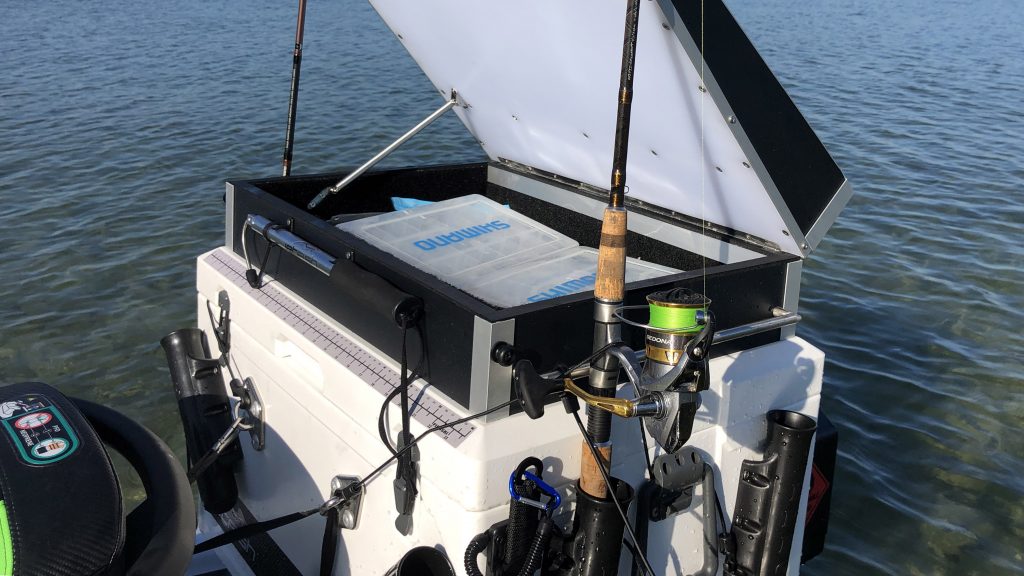
There is also a 1 metre retractable stainless steel gaff to gut fish. The lid has handy latches that keep the top cover open.
The FishSki Deluxe box weighs 28kg. Initial installation can take up to 15 minutes while you adjust the feet and the straps, but it can be removed in less than five minutes.
(The example used in these photos had Jet Fish labels, but FishSki is the manufacturer and the original branding).
The FishSki cooler has more functionality than the Sea-Doo Fish Pro cooler, but it’s heavier, taller, and the lid has sharper edges – and can shut abruptly if the hinges are not locked.
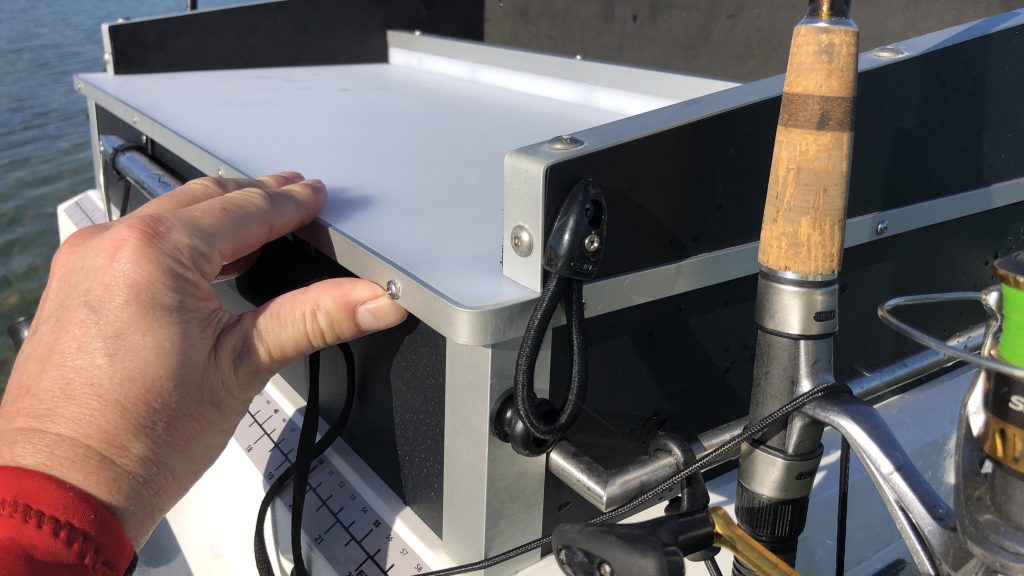
Accessing the two 5-litre fuel cans on the back of the cooler is difficult if you’re on the water.
By comparison, the Sea-Doo Fish Pro’s optional 15-litre fuel caddy can be located on the rear deck between the back seat and the cooler box, which is much easier to access. However, refuelling from the caddy itself is problematic.
Even after detailed instructions on how to use Sea-Doo’s fancy filler hose (which is designed to prevent spilling and improve fuel flow), the petrol barely dribbled out. Neither of these alternatives is an easy option to refuel on the water.
At least the Sea-Doo’s fuel filler neck is located up high under the console; the Yamaha FX HO filler neck is mounted on the nose near the water line, making it extremely difficult to refuel on water.
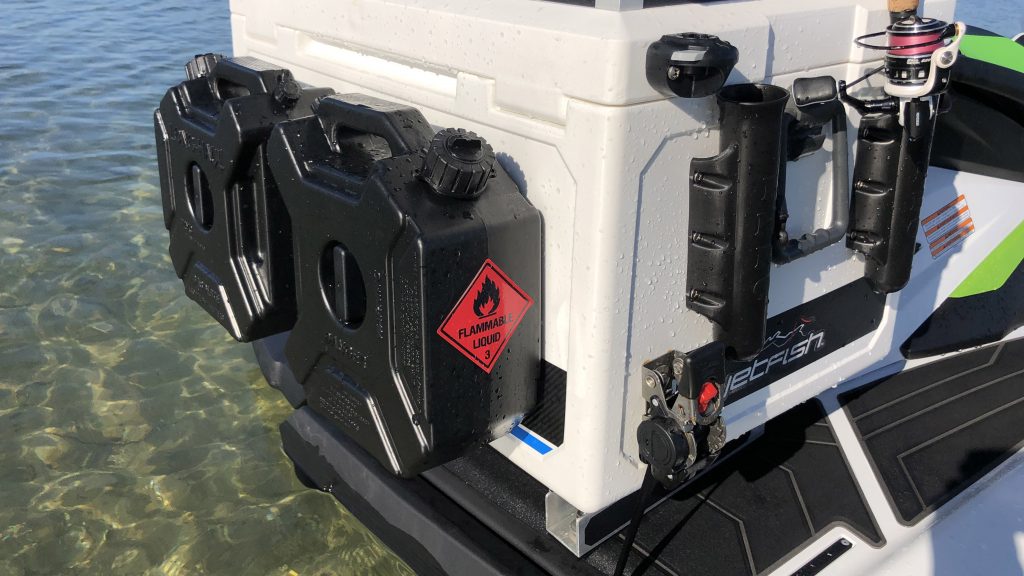
These watercraft would suit…
Both the Sea-Doo Fish Pro and Yamaha FX HO suit dedicated fishing types. However, both models can easily be converted into family leisure watercraft in a matter of minutes by removing the bulky accessories, namely the cooler box.
With the cooler boxes removed, the large rear deck on each ski doubles as a platform to jump off, or to climb back on board. They can also be used for tow sports, though supercharged skis will deliver more power on take-off.
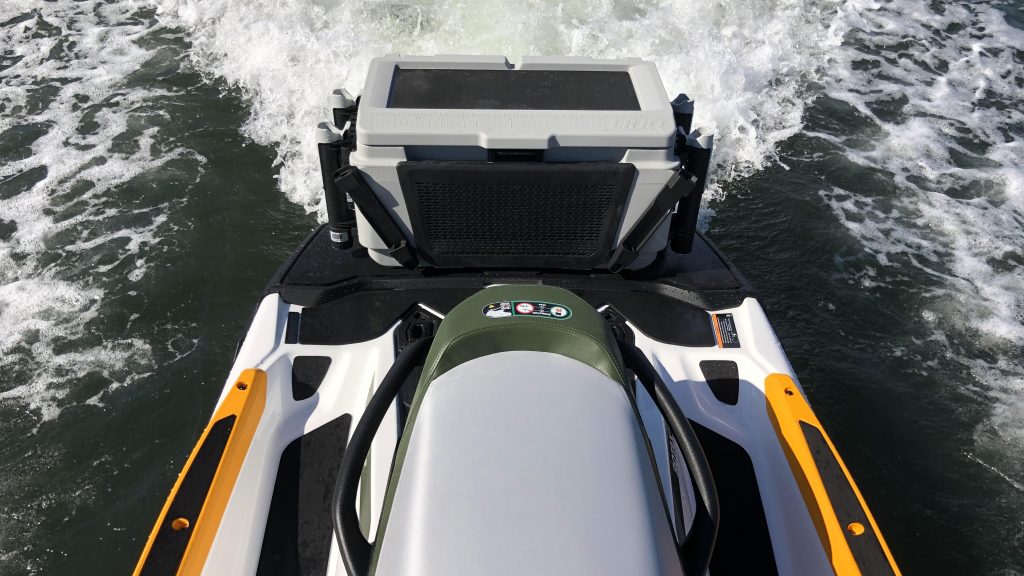
Pros and cons
The Sea-Doo Fish Pro is genius in its design, including the clever and easy access to the front storage area and the way all the accessories click into place.
The Sea-Doo’s handlebars lift up as part of the centre console, making it easy to reach into the main storage area, which is also largely water-tight.
The Yamaha has a larger front storage compartment than the Sea-Doo, however it’s more susceptible to water ingress and you need to balance over the handlebars to access the front compartment when on the water.

The Yamaha has a brighter and clearer digital instrument display than the Sea-Doo, and it’s a touchscreen (a first for the class).
However, the Yamaha’s speedometer is not as accurate as the Sea-Doo because it is based on engine revs (the Sea-Doo uses a built-in GPS to determine speed).
In our experience, the 2019-2020 Yamaha FX fuel gauge is wildly inaccurate. Yamaha introduced a second software upgrade in late 2020 to address fuel gauge accuracy issues. We are yet to test the updated version.

However, the Yamaha FX does have a very accurate “fuel used” meter. As long as you remember to press the reset button when you top the tank, you’ll have plenty of warning before you run dry.
The Sea-Doo has a unique distance-to-empty readout, but this is an estimate based on your current riding conditions and throttle use.
The Sea-Doo’s seat is slightly narrower and flatter, making it easy to manoeuvre from side to side.
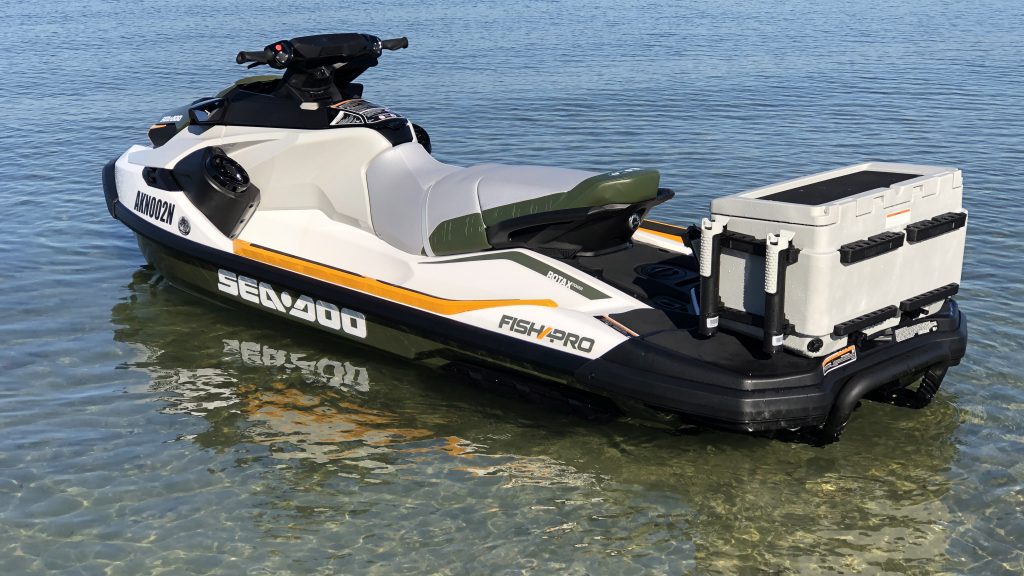
The Sea-Doo’s narrower upper body structure is less likely to rub the inside of your legs.
The Yamaha FX HO’s wider upper body structure and exposed seat stitching can cause a rash on the inside of your lower legs, especially if you stand while riding.
The Yamaha FX has relatively narrow foot wells, which reduces the risk of becoming unbalanced if one side fills with water. The downside is you could accidentally wedge your foot, if you happen to suddenly come off the craft after making too tight a turn.
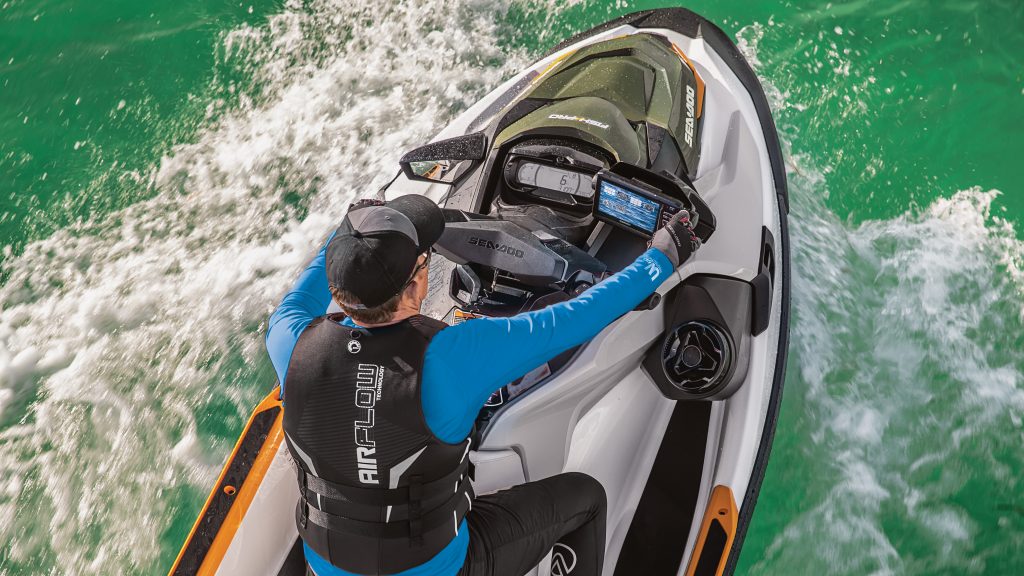
The Sea-Doo has extremely wide foot wells, so there’s more foot room. But the grip mat material is more slippery than the Yamaha. And it’s more angled, which can make it uncomfortable on your knees when standing.
If either of the Sea-Doo’s large foot wells fill with water, the craft can become unstable. However, a quick blast of the throttle will empty the water in the footwells of both the Sea-Doo and Yamaha.
The Sea-Doo’s wedge-shaped handgrips tend to push the your thumbs into the plastic trim of the handlebars, which can create blisters even when wearing gloves. The Yamaha has less dramatically designed hand grips and they feel more comfortable.
On the Yamaha, the navigation unit can be mounted on the left of the centre console (leaving your right hand to control the throttle), however the Sea-Doo navigation unit is mounted on the right only, and replaces the side mirror. For now, there is no option to mount the Sea-Doo navigation screen on the left.
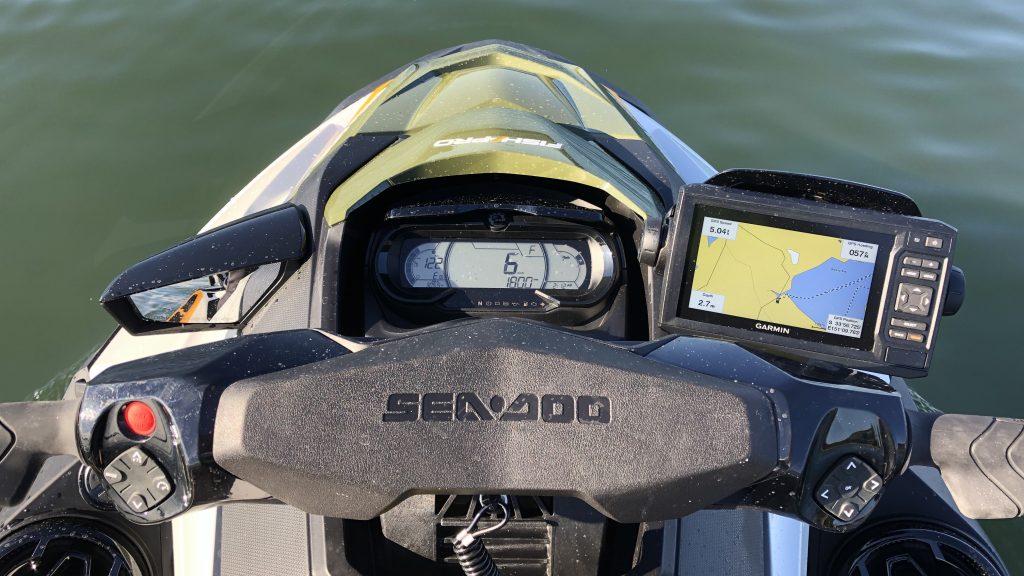
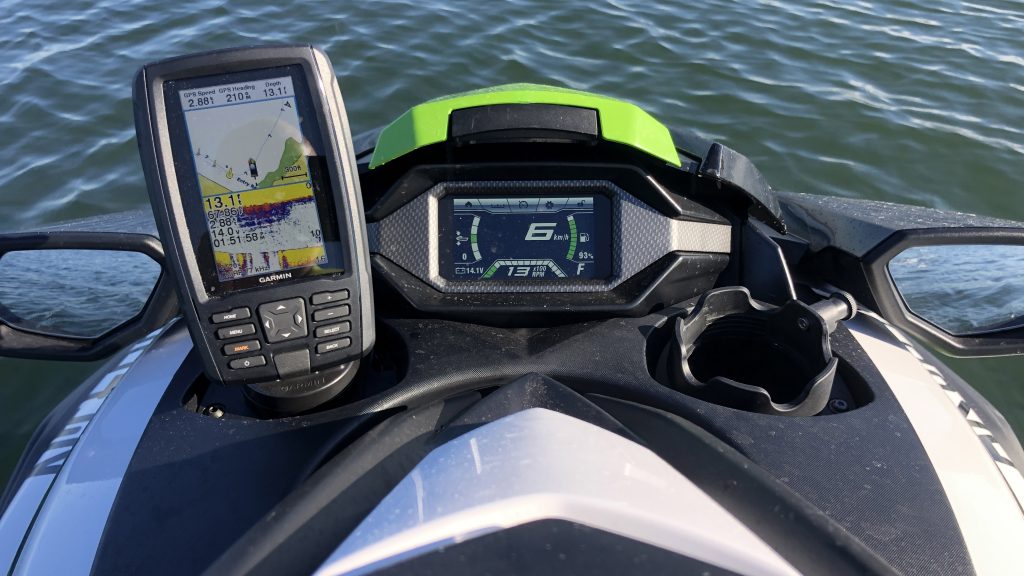
The Sea-Doo Fish Pro tested was equipped with optional, factory-fitted Bluetooth audio speakers ($1000); they have plenty of oomph and the sound quality is good but, as you might expect, the wind blows out the sound while riding at speed.
Yamaha sells optional Bluetooth speakers (price not available as this article was published) that attach to mounts on the centre console. Yamaha is on the second version of these, after the first speaker mounting design didn’t always attach securely.
When equipped to go fishing, both the Sea-Doo and Yamaha are difficult to reboard from the water even when using the rear fold-down step, because the cooler boxes are relatively bulky to climb over.
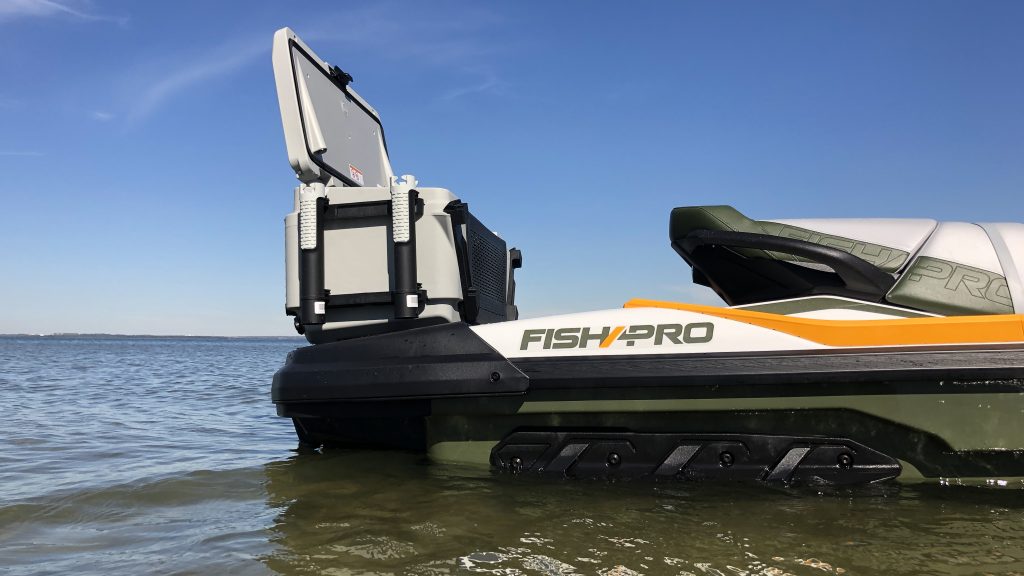
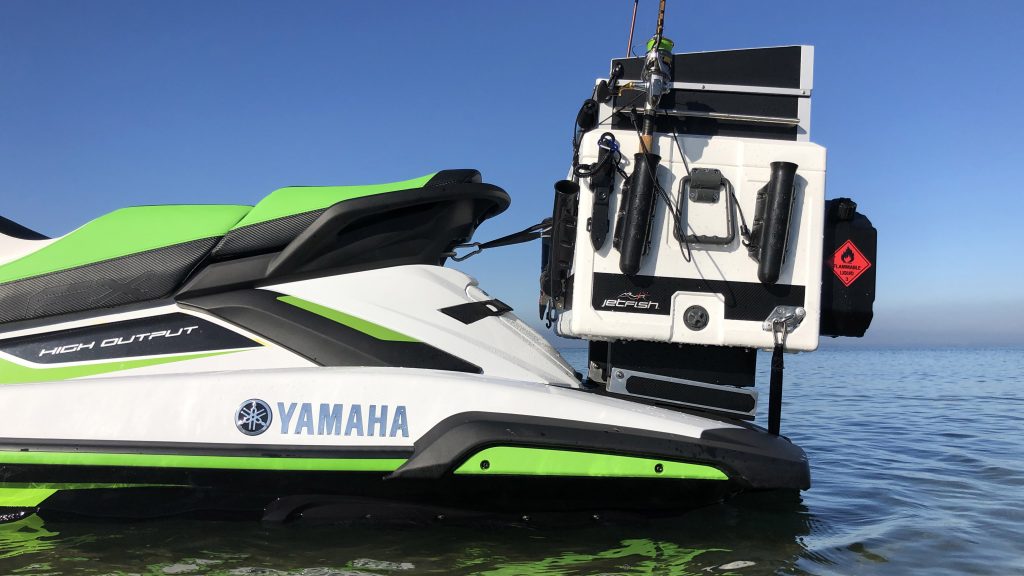
However, the Yamaha FX when equipped with a FishSki cooler box is more precarious to climb over. The box is taller and the edges are sharper, so it’s easy to tear clothing or put a gash in your leg or arms. The Sea-Doo cooler box has rounded, plastic edges, making it more forgiving to clamber over.
The Sea-Doo cooler box grip mat is great for securing your catch (or other loose items) but the kitchen-style cutting board material on the top of the FishSki is more resistant to damage from cutting with knives.
It’s faster and easier to remove and reinstall the Sea-Doo Fish Pro cooler box; the FishSki set-up is more cumbersome and requires more patience. Reinstalling it may also take some finessing as you adjust it properly, whereas the Sea-Doo kit just clips into place.
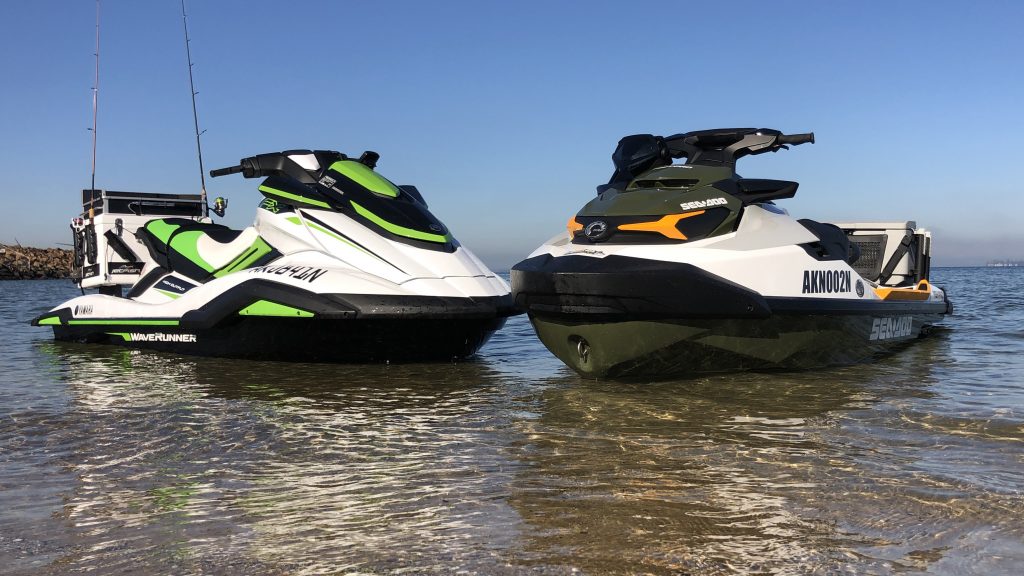
What are they like to ride?
On the water, the Sea-Doo Fish Pro is stable in small to medium chop, but the Yamaha FX is better in rough conditions.
All personal watercraft are beaten around by large swells and big winds, but the more vertical design of the front of the Sea-Doo ST3 hull makes it more susceptible being pushed gently sideways when you’re attacking swell at an angle (when you don’t necessarily have a choice, such as in ocean riding).
The Yamaha FX HO’s slightly more rounded nose and flatter belly – combined with relatively responsive sponsons – help the Yamaha carve through diagonal swell with more confidence than the Sea-Doo.
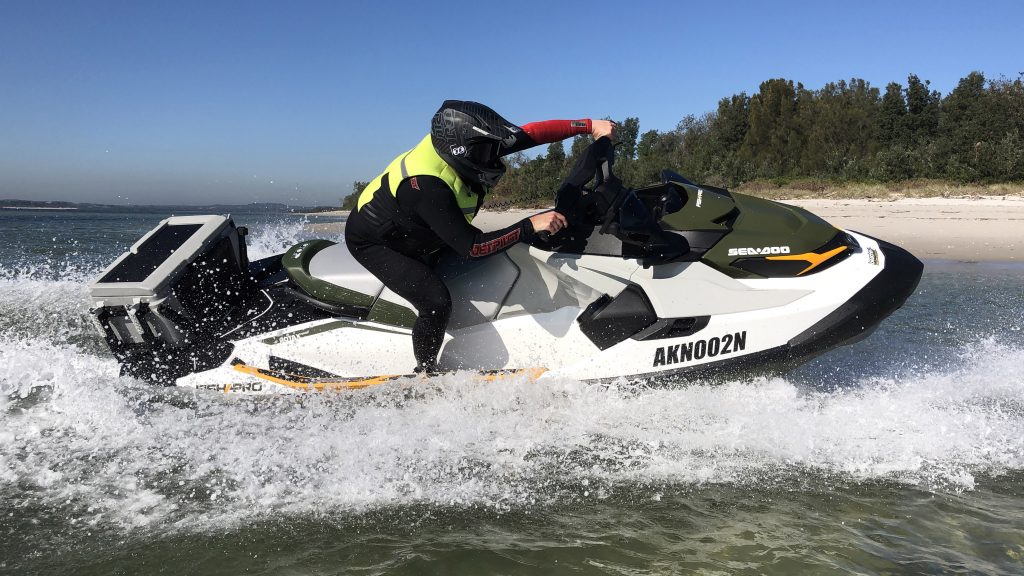
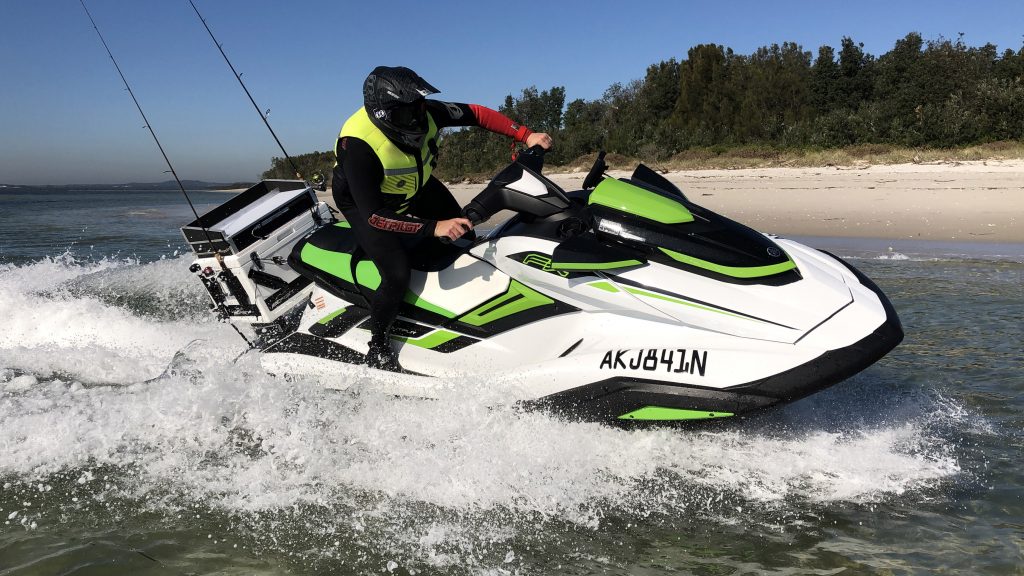
In such conditions with the Sea-Doo, you’re often forced to correct your path, as the force of nature pushes the Fish Pro around; the Yamaha FX HO cuts a cleaner and easier line through the same type of chop.
That said, few riders experience these conditions. We’re only making these observations based on our testing of both these watercraft back to back.
In small to medium chop (and, of course, flat water) both watercraft track confidently and predictably.
The other observation is that the Sea-Doo tends to list ever so slightly – leaning to the left at speed whether it’s in calm or choppy water – though it’s unclear why this is the case.
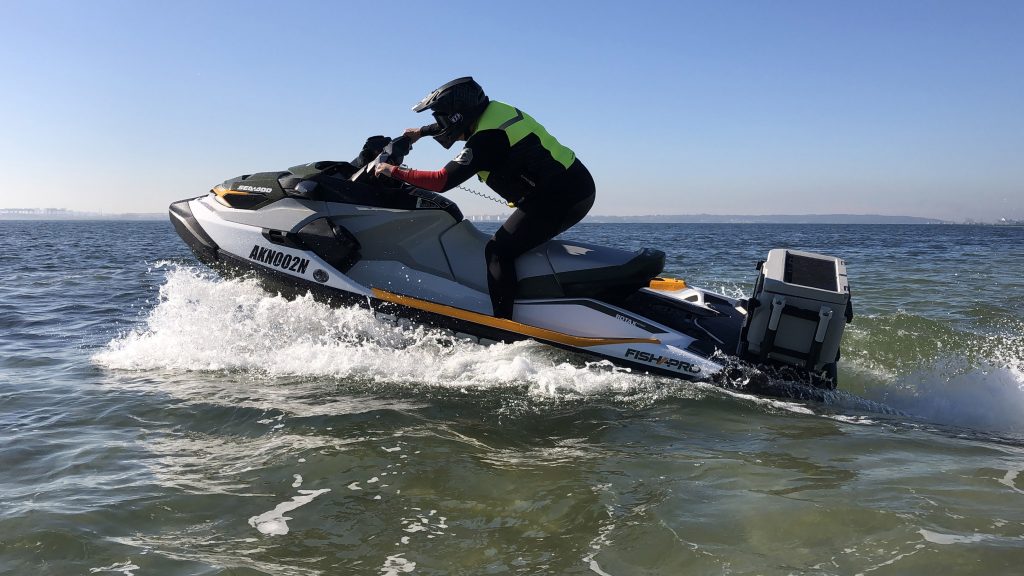
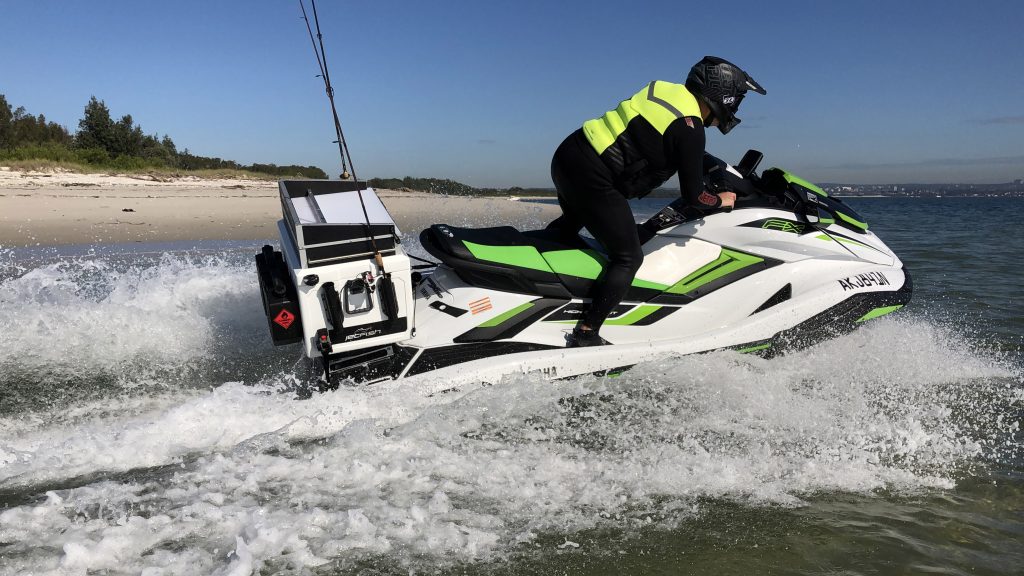
Low-speed manoeuvrability is more intuitive in the Yamaha (both have forward and reverse triggers on the handlebars), though again it is unclear why this is the case. The Sea-Doo seems to carry the momentum of a slippery log at low speeds, the Yamaha is a little less eager and more prone to pull up gently.
However, the Sea-Doo has better “braking” (for the want of a better term) at high speed as soon as you’re off the throttle. The Sea-Doo Fish Pro stops in about half the distance as the Yamaha FX HO from the same speed in the same conditions, as the bucket drops down more aggressively.
While the Yamaha FX HO has a “no wake mode” and cruise control, the Sea-Doo has a slow “trolling mode” which is handy for fishing.
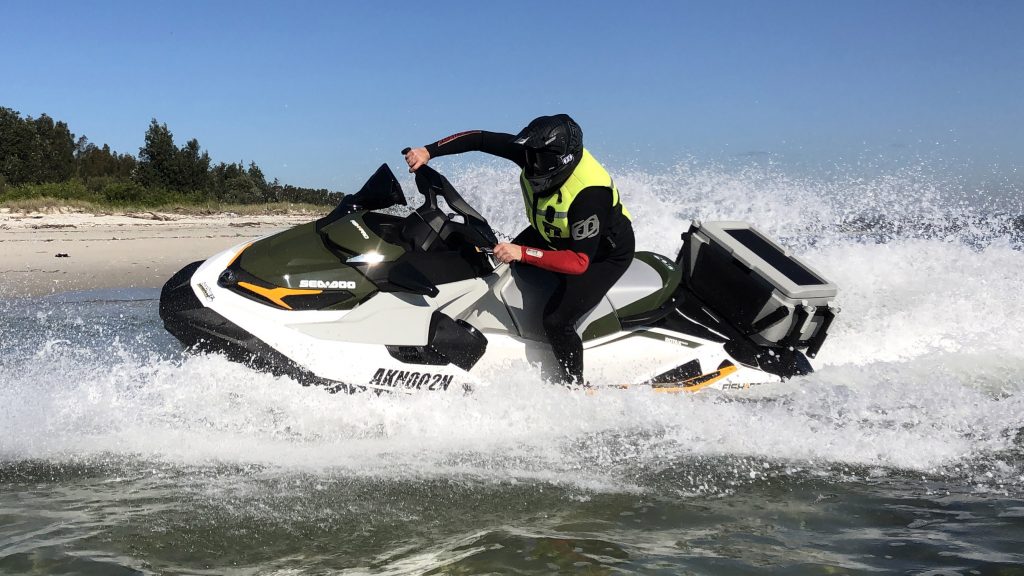
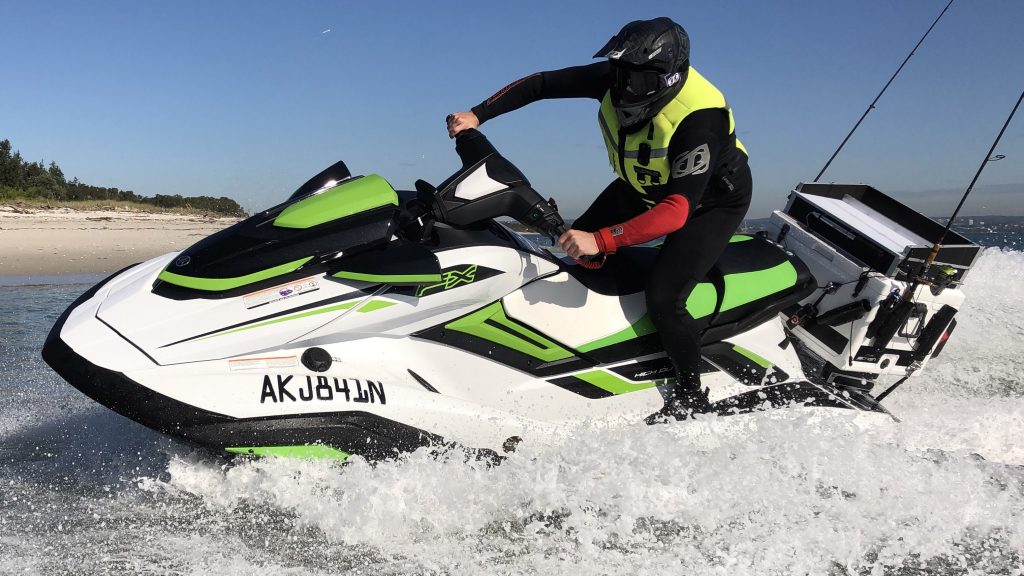
Fuel use
We didn’t put a V-Box on these watercraft, however when lined them up side by side the Yamaha FX HO accelerated quicker and had a marginally higher top speed (93kmh) versus the Sea-Doo Fish Pro 170 (90kmh).
However, the Yamaha FX HO’s performance edge comes at a cost.
With its smaller and less powerful engine, the Sea-Doo Fish Pro used about 45 litres per 100km in our riding conditions, versus about 50 litres per 100km in the Yamaha FX.
Both watercraft have 70-litre fuel tanks, so the maximum riding range is longer in the Sea-Doo Fish Pro.
When we recorded these consumption figures, both watercraft were travelling mostly at three-quarter throttle in medium to rough chop. We were rarely at wide open throttle.
These fuel consumption figures would climb if you were to launch the craft from a standstill repeatedly, travel constantly at wide open throttle, or tow anyone.

Servicing
The service intervals for the 2020 Sea-Doo Fish Pro 170 differ slightly. The Sea-Doo’s service intervals are 12 months or 100 hours (whichever comes first). The 2020 Yamaha FX HO service intervals are 12 months or 50 hours (whichever comes first).
There’s also an inspection recommended by Sea-Doo and Yamaha at 10 hours. Unlike the first inspections on new cars, this early 10-hour check is not free.
Most routine service visits cost between $350 to $450 depending on what’s required.
Most 50 hour services involve an oil and filter change; spark plugs are usually changed every 100 hours.

Warranty
Sea-Doo warranty is two years. Yamaha WaveRunner warranty is three years.
Sea-Doo occasionally offers three-year warranty promotions, so be sure to check.
By comparison, a five-year warranty applies to Kawasaki Jet Skis sold in Australia since June 2020.
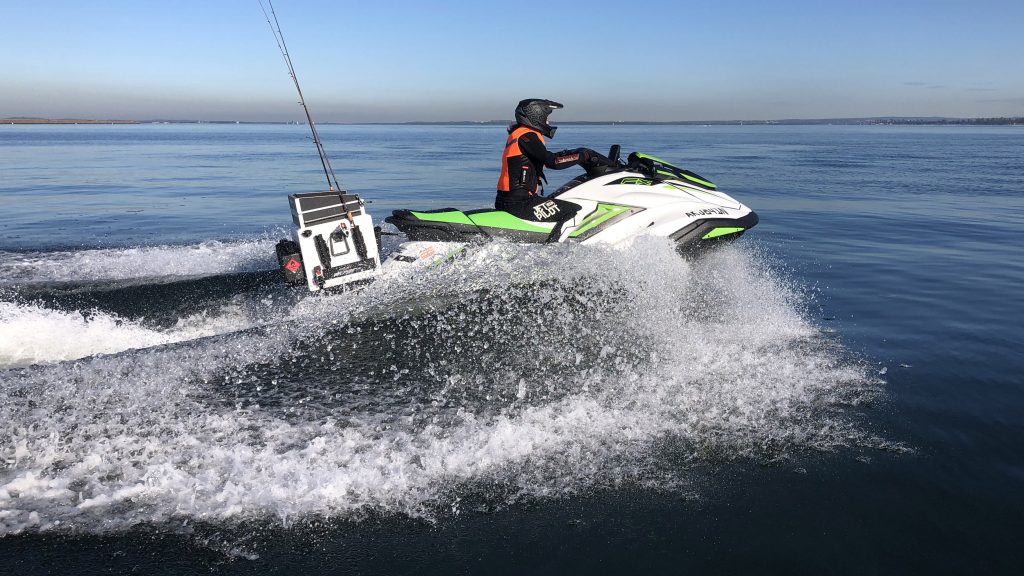
Tips for flushing after each ride
The Sea-Doo Fish Pro should only be flushed for 90 seconds to 2 minutes after each ride; any longer could damage the carbon seal.
Yamaha recommends flushing the FX HO for about 3 minutes after each ride, though some owners run clean water through the system for up to 5 minutes.
For more detailed fresh-water flushing instructions, click here.
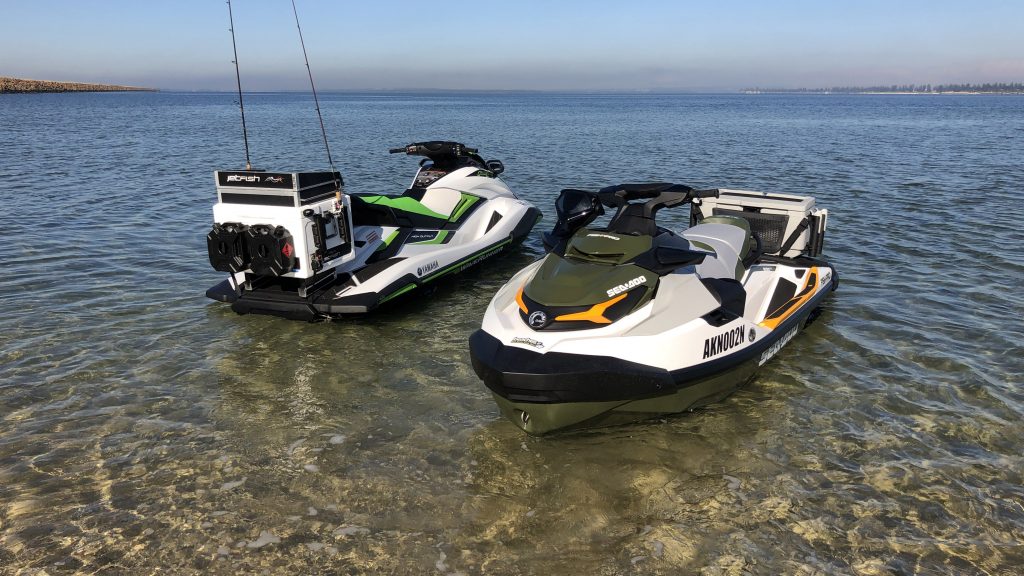
To sum up
In calm waters, there is little to separate these two, aside from the Yamaha’s slightly better acceleration, and low-speed manoeuvrability.
However, we can see why each of these watercraft will appeal to different buyers.
The Sea-Doo Fish Pro is a genius turn-key solution for enthusiasts wanting to fish off a Jet Ski or personal watercraft. The Sea-Doo Fish Pro’s clever ergonomics and relatively frugal fuel economy will give peace of mind to many owners.
The Yamaha FX HO is a great platform for a dedicated fishing Jet Ski or personal watercraft – once the optional FishSki cooler box and accessories are added. The Yamaha FX HO will likely appeal to riders who want more power and who spend more time in rough water.
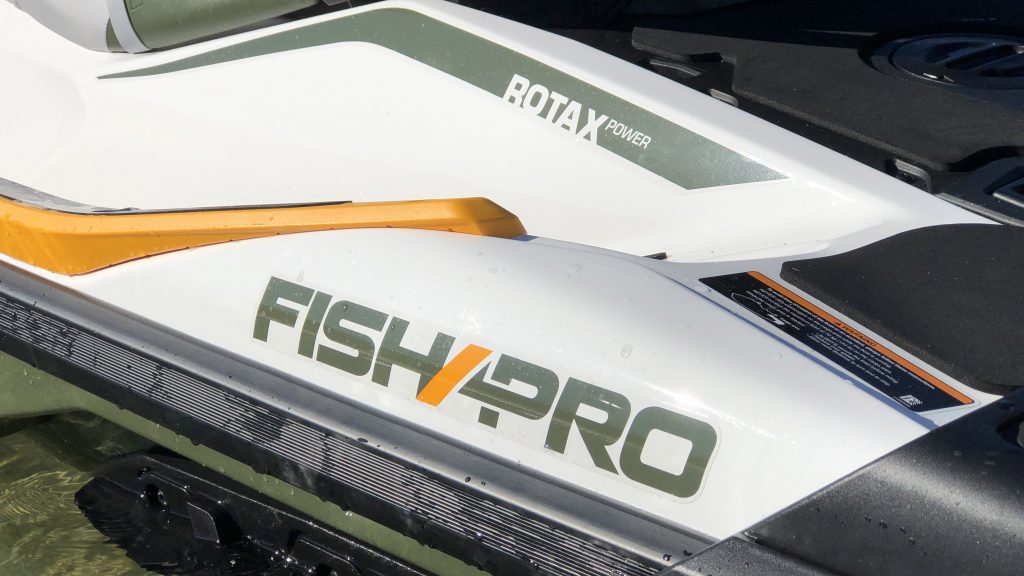
Specifications
Model: Sea-Doo Fish Pro 170
Length: 3.734m
Width: 1.25m
Weight: 389kg (dry)
Engine: 170hp 1630cc 3-cyl Rotax, non-supercharged
Top speed: 90km/h (estimated)
Fuel: 70L
Seating: 3
Warranty: Two years
Service intervals: 12 months or 50 hours, whichever comes first
Priced from: $20,499 with Garmin EchoMap Plus 62cv fish finder, fishing seat, 51L cooler box, extended rear platform with accessory attachment, angled gunwale footrests, storage bin organiser, trolling mode, 4 rod holders.
Options: Bluetooth audio speakers ($1000).
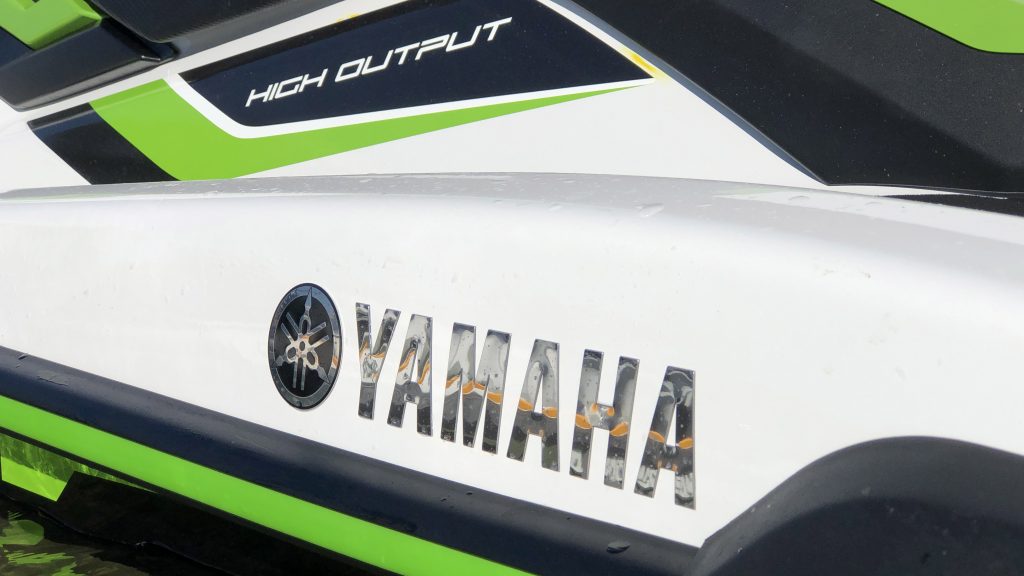
Model: 2020 Yamaha WaveRunner FX HO
Length: 3.58m
Width: 1.27m
Weight: 380kg (dry)
Power: 1.8-litre four-cylinder, non-supercharged. Power output not disclosed
Top speed: 93km/h (estimated)
Fuel tank: 70L
Seating capacity: 3
Warranty: Three years
Service intervals: 12 months or 50 hours, whichever comes first
Priced from: $20,499 (not including trailer and rego) with 4.3-inch wide digital touchscreen display, three-speed no-wake mode, 130-litre storage area, 16.6-litre waterproof compartment in front of the seat, waterproof bucket with twist-top lid under the rear seat.
Options: FishSki 68-litre cooler box ($1249), Garmin ECHOMAP ($499).
Review watercraft supplied by Yamaha Marine Australia and Beaches Sea-Doo & CanAm.
MORE: All our Sea-Doo coverage in one click
MORE: 2021 Sea-Doo prices
MORE: All our Yamaha coverage in one click
MORE: 2021 Yamaha WaveRunner prices



